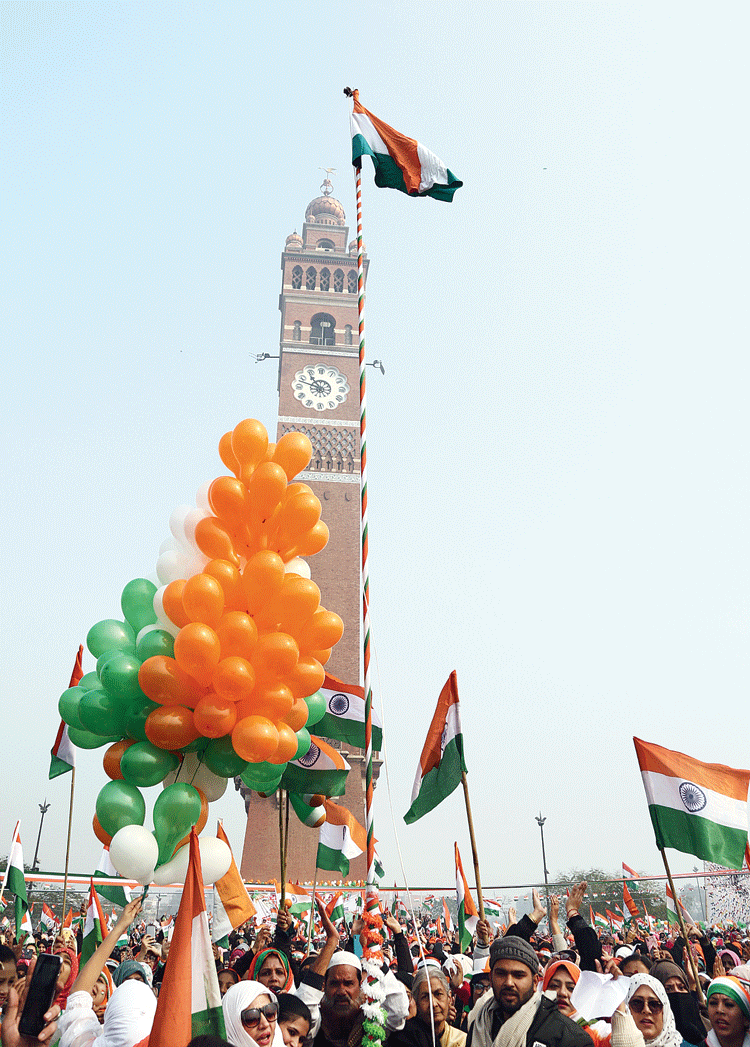At least 25,000 women and children gathered outside Lucknow’s Ghanta Ghar on Republic Day while others formed a human chain around the landmark clock tower’s courtyard, making Sunday’s turnout the highest since anti-citizenship-act protesters started converging at the spot on January 17.
“Tiranga hamara, desh hamara; bhagwa tumhara, sirf bhagwa tumhara (The Tricolour is ours and so is the country; the bhagwa is yours and only bhagwa is yours),” they chanted, referring to the Sangh’s saffron flag.
The excitement was palpable; from around 40 protesters on the first day and 400 on the next, when police are alleged to have snatched their blankets and stolen biscuit packs, their number has been rising.
The police have denied the allegation and said outsiders had entered the protest site for the blankets, forcing them to act.
But the women had pressed on, undeterred by such distractions. Over 5,000 women and children gathered at the site on January 19, the day after the alleged police action, while another thousand joined on January 20.
The police targeted the protesters again on Saturday (January 25), arresting Pooja Shukla, a student of Lucknow University, and seven others on charges including unlawful gathering and incitement to violence.
Saturday’s action seems to have enthused the protesters even more. “It was on our shoulders that the Republic of India travelled 70 years,” a 30-something woman, Tricolour painted on her right cheek, told The Telegraph.
“Most of the women you see here today rushed to the clock tower in the morning directly from their kitchens to celebrate the day. A few thousand are staying here night and day.”
This is happening, she said, because the Constitution of India is in danger. “We have no other option but to step out and take the responsibility of hoisting our Tricolour ourselves.
“There is another celebration going on in front of the Uttar Pradesh Vidhan Sabha, 8km from here, where those people are hoisting the Tricolour, (those) who came to power while misusing our shoulders.”
The state government celebrated the day by holding several cultural events in front of the Vidhan Sabha, and attended by governor Anandiben Patel and chief minister Yogi Adityanath among others.
The young woman refused to identify herself. “The policemen read the newspapers, see news channels, note down our names in their dairies and then register false cases against us,” she said.
Over 250 women have been booked in Lucknow in the past week for protesting at Ghanta Ghar in Husainabad and Ganj Shahida Dargah in Gomti Nagar.
“Our ancestors — Muslim men — used to unfurl the Tricolour in the past, and now the women are doing this. Those who have amended the citizenship act to ostracise the Muslims used to oppose the Tricolour and wanted the bhagwa to be adopted as the national flag; now they are hoisting our flag (the Tricolour),” she said.
“Do you understand its meaning?” she asked before going on to give the explanation herself. “We had won against them in the past and we will win against them this time too.”
On the eve of Independence, the RSS mouthpiece Organiser had declared the Indian Tricolour would “never be respected and owned by the Hindus. The word three is in itself an evil.…”
After the first Republic Day in 1950, the Sangh did not hoist the Tricolour at its Nagpur headquarters, sticking to its saffron flag on both January 26 and August 15. It changed the practice in 2002 when Atal Bihari Vajpayee was the Prime Minister.
At Ghanta Ghar, in a corner of the courtyard, around 30 women, all in black veils and carrying small paper Tricolours, chanted: “We have fought and we will fight, we have won and we will win.”
Police and paramilitary personnel stood watching as men, mostly family members of the protesting women, managed the traffic and the crowd. The men also formed a human chain around the courtyard.
Some policewomen could be seen moving among the protesting women and children and staring at each and every face as they passed through.
“We have no problem as long as the protest is peaceful,” said Pramod Kumar Mishra, station house officer of Thakurganj under which Ghanta Ghar falls. “We arrested a woman and seven men on Saturday because they were trying to instigate violence. We are also keeping a close watch on those who are raising anti-national slogans and will take action eventually against them.”
At Ganj Shahida Dargah, around 18km away, the police entered the protest site.
“Some policewomen have entered the area where the women are organising a dharna and are calling them Pakistani agents,” a woman said over the phone to this correspondent around 11.30am. “The women police also snatched the national flag from us.”
When this reporter reached the spot at 1:30pm, over a dozen women and men in khaki were still on the platform of the dargah, where about 100 women and children were on dharna.
Amit Kumar Dubey, station house officer, Gomti Nagar, said: “They are doing whatever they want to. We neither ask them to do anything nor stop them.”










